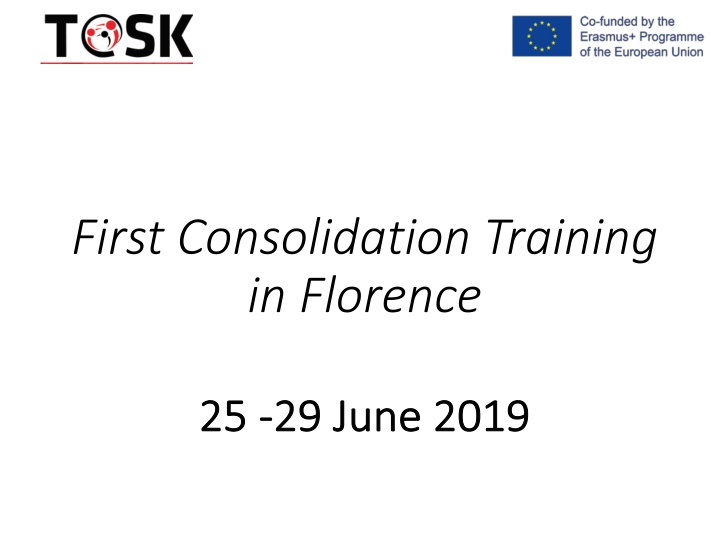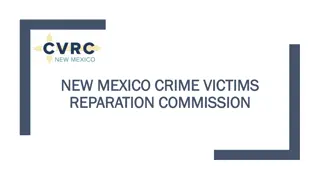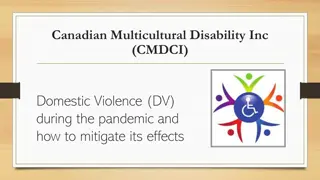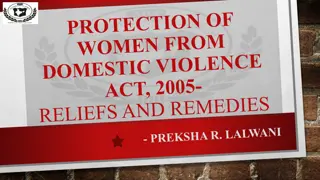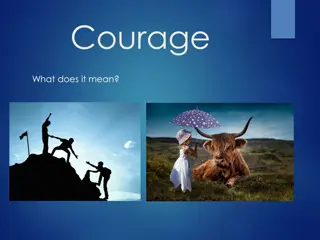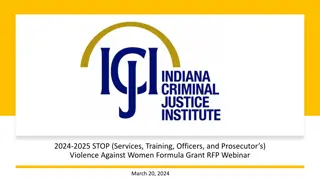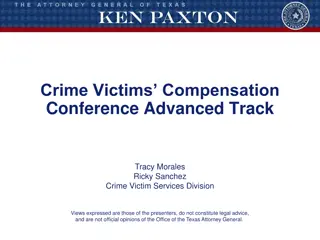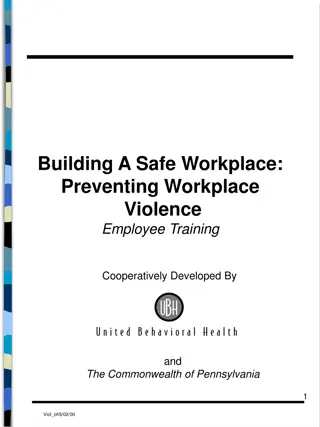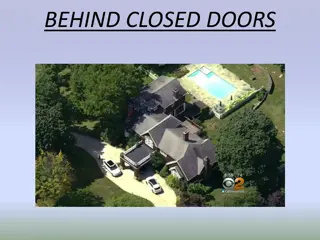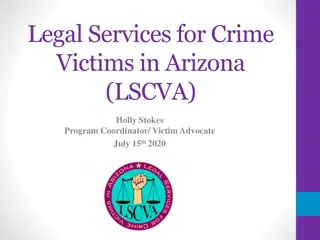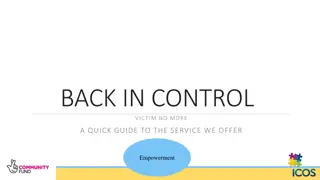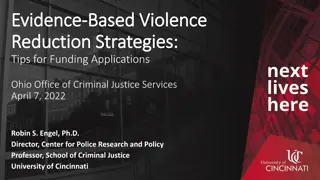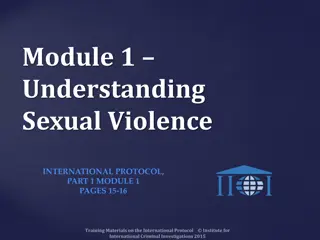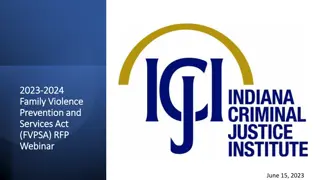Artemisia Association - Empowering Victims of Violence in Florence
Artemisia Association, established in 1991, is a key support center aiding women, children, and adolescents facing violence. Named after Artemisia Gentileschi, a pioneer in speaking out against abuse, their mission tackles various forms of violence by providing assistance, counseling, and awareness campaigns. Their interventions include preventing violence, raising awareness, and addressing the long-term impacts of abuse on individuals. The association's work focuses on combating intimate partner violence, sexual violence, stalking, economic violence, and the effects of feminicide on women and children.
Download Presentation

Please find below an Image/Link to download the presentation.
The content on the website is provided AS IS for your information and personal use only. It may not be sold, licensed, or shared on other websites without obtaining consent from the author.If you encounter any issues during the download, it is possible that the publisher has removed the file from their server.
You are allowed to download the files provided on this website for personal or commercial use, subject to the condition that they are used lawfully. All files are the property of their respective owners.
The content on the website is provided AS IS for your information and personal use only. It may not be sold, licensed, or shared on other websites without obtaining consent from the author.
E N D
Presentation Transcript
First Consolidation Training in Florence in Florence First Consolidation Training 25 25 - -29 June 2019 29 June 2019
WHO WE ARE WHO WE ARE Artemisia association, founded in 1991, is an independent specialized center , that provides assistance to women, children and adolescents victims of violence. The association takes its name from Artemisia Gentileschi, painter of the '600, that was the first woman to denounce and faced a rape trial. Artemisia offers assistance to women with problems of physical, psychological, sexual and economical violence and helps children victim of sexual violence and/or child abuse and neglect and their protective parents/adults. It also offers counselling for adults that have been victim of violence in childhood and are still suffering from the long term effect of these violence.
Mission Mission Violence against women and children is a violation of human rights, it is a traumatic experience whose wounds are not limited to the physical realm. The association operates against all forms of violence because we believe that violence, however it occurs, is unacceptable, unjustifiable and it produces a deep trauma that affects many aspects of a person's life.
The most common type of violence we handle . Intimate partner violence, including physical, sexual, and emotional abuse Sexual violence, including conflict-related sexual violence Stalking Economic violence Trafficking Effect of Feminicide
The most common type of violence children Maltreatment: physical and psychological/emotional violence, and neglect . Bullying (including cyber-bullying) Sexual violence includes non-consensual completed or attempted sexual contact and acts of a sexual nature not involving contact (such as voyeurism or sexual harassment); acts of sexual trafficking committed against children. Emotional or psychological violence includes restricting a child s movements, denigration, ridicule, threats and intimidation, discrimination, rejection and other non-physical forms of hostile treatment
Main areas of Intervention PREVENTION AND AWARNESS RAISING Bring out the problem of violence and sexual abuse against women, boys and girls. Sensitize the territory with respect to issues such as WITNESSED VIOLENCE, LONG-TERM EFFECTS on adults victims of sexual abuse or violence in childhood and the damages caused by domestic violence against women and their children. Investigate the issue of detection and prediction of risk levels, developing appropriate means of action. Contribute to the emersion and recognition of all forms of violence against women, children and adolescents and interrupt any situations of violence against them.
Main areas of Intervention SECONDARY AND TERTIARY PREVENTION Services emergence and recognition of all forms of violence against women and children - a help hotline stop situations of violence and take urgent measures of protection legal advice, two shelters for single women and women with children programs of INDIVIDUAL empowerment programs of working reintegration programs of stabilization for the psychological effects of violence psychological counselling (individual, couple, family, groups) psychoterapy support the recovery of a positive parenting advice for professionals suspecting situation of child abuse collaboration with police , Penal Courts and Juvenile Court for assessment and protect victim hearing
Organization Organization Access First request by telephone or direct Risk assessment Outcome Path of advice and support Psychological support program Social support program Working and housing reintegration Legal advice and support Shelter Houses These actions are managed by a team of about 40 voluntary operators and consultants who have special training in counseling and crisis intervention in situations of violence.
Additional Additional services In the years we ve promoted some projects to offer additional services : L ASILO CHE NON C E (The nursery that doesn t exist). A nursery school open in the closing days of other nurseries, to support mothers who work and need a safe place for their children. AUSER ABITARE SOLIDALE (Auser Live in solidarity). Its goal is to activate pathways of cohabitation between elderly people and women victims of violence in need of an accommodation. A cohabitation based on a pact housing that provides a mutual exchange of services in lieu of the traditional rental contracts. Schools Project. We work to raise awareness in schools of all levels to promote gender equality Project Good purpose & Food Bank . Distribution to women and children in financial difficulties of clothes, small household items, toys. Free distribution of fresh food products donated by COOP and by the Food Bank Project I care about me . Distribution to women and children of soaps, creams and beauty products. services
During the years Artemisia has created a network of help together with regional and local government officials and institutions.
Artemisia is part of the local system of social services Since the 1980s, the changes in the socio-economic conditions that characterized the previous thirty years of prosperity were registered throughout Europe. Different welfare systems were put under various pressures and took a range of directions in response to change: the private sector was given an increasing role. In Italy , new social demands came up. One result of those processes is the reform (partial) of the Italian welfare - law n. 328 of 2000 Consolidating Act for the creation of an integrated system of social policies and services which draws up a system of social policies and services based on a subsidiarity between public and private sectors (mainly Third sector that is non-profit making , associations, cooperatives, ecc). This institutional construction presupposes the public s ability to manage the overall governance of the system - programming, direction, regulation, integration, and control and private sectors offer specialized interventions.
Private/third sector organizations were called not only to manage the services - as increasingly happened during the previous decade - but also and more importantly to co-design the system. Today, non-profit organizations (as Artemisia) play a crucial role in providing social services and contributing to achieving social policy goals. As a consequence of the decentralization of health and social services subjecting non-profit organizations to local authorities, as well as flowing from the recent increase in the number of services being contracted to these organizations by local authorities, some areas of health and welfare are heavily dependent on the non- profit sector. The integrated system of social policies and services has amongst its tasks also that of the promotion of social solidarity, accompanied by the appreciation of the initiatives of individuals, family units, and forms of self and mutual help and of organized solidarity
CISMAI Italian network of public and private agencies working on prevention of child abuse, protection of child victims and treatment Aims to establish a permanent cultural and educational presence to address the issues of prevention and treatment of violence against children, particularly with regard to intra- family abuse. CISMAI is the Italian partner of ISPCAN the international Society for the 0reventin of child abuse and neglect 60 organizations are members and over 70 individuals professionals Artemisia held the presidency from 2004 to 2008.
Few data on Artemisia From February 1995 (when we opened the counselling center) to December 2018, the Association has been responding to 16.628 requests for help and support 12.001 women victims of violence 3785 children and adolescents victims of physical, psychological ill-treatment, sexual abuse, witnessing violence 842 adults asking help for the long term effect of violence happened in childhood Since 1999, when we opened the first Shelter House, we hosted 185 women and 199 minors.
Trauma We work with Trauma. Trauma includes one-time, multiple, or long-lasting repetitive events, affects everyone differently. Some individuals display criteria associated with posttraumatic stress disorder (PTSD), but many more persons exhibit resilient responses or brief subclinical symptoms or consequences that fall outside of diagnostic criteria. The impact of trauma can be subtle, insidious, or outright destructive. How a traumatic event affects an individual depends on many factors, including characteristics of the individual, the type and characteristics of the event(s), developmental processes, the meaning of the trauma, and sociocultural factors.
We work on the consequences of Adverse Childhood Experiences (Felitti, 2009) Adverse Childhood Experiences (ACEs) is the term used to describe all types of abuse, neglect, and other potentially traumatic experiences that occur to people under the age of 18. Adverse Childhood Experiences have been linked to risky health behaviors, chronic health conditions, low life potential, and early death. As the number of ACEs increases, so does the risk for these outcomes.
Our work needs an high level of specialization for handling correctly the effects of traumatic experiences. The volunteers and consultants (associated to Artemisia) have regularly supervision and training. There is an high risk of burn out due to the level of danger and risk we have to handle in order to protect women and children.
Problems in the process of intervention Difficulties in coordination with other services , police, judicia authorities PROTOCOL, GUIDELINES Delays and overlappings in interventions. Lack of specialization among some professionals. Minimization, negationism, reductionism in relation to the events or their consequences on women and childre, e.g. named conflict instead of domestic violence, or he was bad with the mother but a good father for children..
A recent FOCUS INATITUTIONAL ILL.TREATMENT
SASCA In cadrul proiectului european SASCA www.sasca.eu (Support to Adult Survivors of Child Abuse in institutional settings). Scope of the project Reveal the persective of young people who spent their childhoods, or parts of it in a residential home in Italy, Greece and Romania. Understand the perspective of professionals and their attitudes towards the issues faced by children in residential homes Analyze the modalities of therapeutic, social and judicial assistance which can improve the lives of young people who suffered different forms of violence in residential care. SASCA: Roth et Al, UBB, Cluj 24
Key Key components of institutional abuse (IA) components of institutional abuse (IA) Role Role of of the perpetrator perpetrator(s (s) for the child (protection givers, ecc) SETTINGS AND ITS SETTINGS AND ITS CHARACTERISTICS CHARACTERISTICS (residential care facilities, non residential arrangements - fostering, for example) the Dynamics Dynamics in the social and in the social and institutional institutional environment (denial, minimization, justification, collusion, ) Type Type of of child (sexual, physical, psychological, etc) child abuse abuse environment Institutional abuse has no single cause, and it is not the responsible of the direct author, it is often the results of entire system which colludes, covers, justifies and sometimes motivates violence against children. 25
Context, previous data: Different forms of child institutional abuse that need prevention and supervision Death of institutionalized children (Miles and Irvine, 1992; Parker and Miles, 1997; Lack of basic standards of privacy (Counsel and Care, 1991; 1995) Medication abuse (Akid, 2002; Chambers, 1999; Hansard, 2002) Neglect associated with under nutrition (Aziz and Campbell-Taylor, 1999; Dodge, 1998). The use of restraint (Brungardt, 1994; Liukkonen and Laitinen, 1994; Ljunggren et al., 1997; Mapp, 1994; Marks, 1992; McDonnell, 1996; Sullivan-Marx, 1995) Poor physical care and quality of life (Commission for Social Care Inspection and Health Care Commission, 2006 Nursing staff burnout (and burnout amongst other grades of staff) (Duquette et al., 1995; Heine, 1986; Schaufeli and Janczur, 1994; WHO, 1995) Organisational factors leading to low standards of care (Commission for Health Improvement, 2000; Wardaugh and Wilding, 1993; Wiener and Kayser-Jones, 1990) Fraud in nursing homes (Halamandaris, 1983; Harris, 1999; Harris and Benson, 1999) Resistance to change in care (Smith, 1986) SASCA: Roth et Al, UBB, Cluj 26
Findings (SASCA Review and survey with professionals) IA is not recognized as a crime in any of the SASCA project partner countries. There are cases of aggravating circumstances (e.g. if the author is a public official) however, it is always a personal qualification, with which one recognizes only an individual responsibility, but never as a system s one. Even the international conventions (CRC, Lancarote, ecc.) do not focus IA as results of individual and collective actions (COL: corporate liability but only for private sector) Cases analysed makes IA similar to the violence of TOTAL INSTITUTION (Goffman, 2001) - a sense of depersonalization and disconnection, physical and psychological isolation from family, community and culture. (Il Forteto, The Magdalene) Cases analyzed reflect IA as secondary victimization , it causes further direct suffering for the victim (new violence) and/or indirect one (stygmatization,e.g. Lerner belief in a just World the victim's suffering is linked to his/her behaviour: that is, his current suffering is somehow "deserved ) 27
In SASCAs cases the disclosure of institutional maltreatment produced : minimization of suffering; blame and devaluation of the victim; tendency to remove the problem. Many people , also with important institutional roles, tend to remove or even deny the overt evidence, and they influence the majority of the population. The veiled perception, but not too much, is that we are the problem because "your" denounce put in crisis pre-existing equilibriums and you damage the economy of a territory .Basically we will have to keep quiet . 28
In our experience the disclosure of institutional maltreatment produced : minimization of suffering; blame and devaluation of the victim; tendency to remove the problem. Many people , also with important institutional roles, tend to remove or even deny the overt evidence, and they influence the majority of the population. The veiled perception, but not too much, is that we are the problem because "your" denounce put in crisis pre-existing equilibriums and you damage the economy of a territory .Basically we will have to keep quiet . 30
ALONE. Is a synergy really possible between the victim's healing path and the process of recognizing the institutional and professional responsibilities? I felt that I had not value for anyone I felt "abandoned without protection No-one wanted to know at the time, no- one want to know now "I think they should have worked differently ...we were only a formal problem .NOT ONLY SHEETS, not just BUROCRACY ". Such a place should have not be allowed to exist, there were children to be controlled! We were trapped You came back home and nothing was changed, and I stayed even worsen adding violence to violence The survivors dehumanized: We were not administrative problems we were children The literature underlines among the widespread effects of the trauma the breaking of the bonds and the destruction of the sense of belonging to the Community and identifies, among the main factors of recovery from the trauma, collective or individual, social support (Yule, 2000). 31
The professionals, the people who were supposed to take care of them belonging to the social, health, judicial authorities, and even in some of our cases the Church and the regional government sectors- made the violence, not only acceptable but even possible.. To recognize the institutional maltreatment implies necessarily to question oneself, one's methodological tools, one's own professional practices ... The healing process needs healing process needs: An individual path for An individual path for reconstructing the survivor s system of meaning and for elaborating the traumatic memories An institutional process An institutional process, a professional process of recognising and re-discussing what happened, how it was possible, the system of meanings and the individual and collective responsibilities. 32
Institutional responsibility: Identification of high quality standards Provision of high-level quality services for societal growth and developing individual and social well being Monitoring on the respect of the standards impose rules and laws that prevent illegal and unethical behaviours that harms individuals as well as institutions. Professional responsibility: to ensure the honor of the profession per se . the individual professional takes responsibility for possible consequences of his/her actions, and does not transfer these consequences on somebody: on God, unfavourable circumstances and so on (Baranova, 2007, p. 150) 33
"How do you tell? Do they believe you? When the survivors disclose, generally, the crime is prescribed. The prescription confirms that victims are invisible and without justice. The prescription is a serious obstacle to access Justice. The awareness of the trauma derived from IA requires the adoption of a Transitional justice approach Transitional justice approach. Transitional justice consists of judicial and non-judicial measures to remedy the serious consequences of human rights violations : criminal proceedings, the setting-up of commissions to bring out the truth, remedial programs and various types of institutional reforms aimed at recognizing responsibilities, recognizing victims and their rights to compensation. The institutional atrocities that lead to systematic abuses devastate the trust towards institutions , and can make democracy more vulnerable. 34
IL FORTETO The residential community The Forteto was founded in 1977 by Rodolfo Fiesoli, Luigi Goffredi and a group of 33 people as a model of communitarian life for taking care of children (or adults) with physical and mental disabilities and/or victims of violence in the family. The Forteto was also an agricultural cooperative, which over the years became a very big and rich economic actor at the regional and national level. On January 1985, the Penal Court of Florence sentenced Fiesoli and Goffredi definitively for physical and sexual violence against a disabled person of the community and for the sexual violence against two young men with mental disabilities in the presence of a thirteen-year-old.
The Juvenile court persisted to send children to the community and the local institutions continued to support the Cooperative. In 2000, the European Court of Human Rights sentenced the Italian State to pay more of 100.000 euros to a mother whose children had been sent to the community where she for a long time was not able to meet them-. Despite this, once again, Forteto continued to gain trust from the institutions. The social services and the Juvenile Court continued to send children, and none did monitoring on the children and their living condition. Children who lives in the community were systematically abused physically, psychologically, emotionally, sexually and forced to work hard.
Il Forteto received for years sympathies from political and institutional personalities, from intellectual and some Church s members. In 2017 Rodolfo Fiesoli and Luigi Goffredi were sentenced for physical and sexual violence, torture, psychological violence, exploitation of child labor, etc. Moreover, other 16 persons were sentenced for the same crimes. Over 80 children were victims of ALL TYPES of violence. Nobody is in prison. Many crimes were prescripted before or during the trail
Supportto Adult Survivors of Child Abuse in institutional settings The community IL FORTETO operated the systematic breakdown of any relations: with families of origin, between brothers, between the inside of the community and the outside world between men and women; The ultimate goal was to allow a unifying control and conditioning.
The institutional response to Il Forteto Two Regional Inquiry Commissions A system of governance to address the actions at a local level: a committee formed by representatives of regional Government , local municipalities, social services, Health services, School, NGOs working in the field, the Association of the victims of Il forteto; A multiple years project OLTRE to support victims is financed by Regional government to guarantee interventions and specific aid for the victims through local services 39
THE SOCIAL CAMPAIGN FOR ASKING JUSTICE promoted by the victims I STAY WITH THE VICTIMS I AM A VICTIM of Forteto and of lack of Justice 40
Against institutional abuse, it is necessary: to build a common understanding of what happened through sensitization, information, knowledge of the events; to re - conceptualize the meanings of institutional abuse to re build the possible of the victims to believe in the institutions, in the community in her/his value ; to valorise the active role of the victims; to adopt measures for a transitional Justice; to overcome the obstacle of prescription; To remove the gaps that still make the institutional abuse possible: lack of systematic monitoring after the removal of the child form home; turn over to the professionals having the responsibility of the protection project for the child; lack of procedures to guarantee that the children are periodically heard. 41
